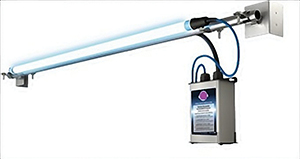Utilizing UVGI technology, operators and agencies can provide cleaner air, longer HVAC life
BUSRide Maintenance recently spoke with experts from SanUVAire, makers of an indoor air purification and surface sanitization system, about the benefits of Ultraviolet C (UVC) on transit and motorcoach environments, as well as the maintenance and lifecycle savings operators can realize for their HVAC systems.
What is air-purification technology and how does it apply to the transit and motorcoach industries?
This is a broad question that entails listing the various technologies and their pros and cons.
Essentially, there are several available air-purification technologies that are primarily found in the residential and commercial markets: ozone / plasma systems, bi-polar ionization systems, negative ion systems, PCO, Bio3, HEPA filters, and carbon. While they all work differently and have benefits, they also have harmful side effects. Furthermore, they may be fit for residential and commercial applications, yet not a fit for a motorcoach.
 UVC – in the form of Ultraviolet Germicidal Irradiation (UVGI) – seems to be a good fit anywhere, with very few limitations and non-existing harmful side effects. There is only one technology that is designed, patented, licensed, tested, evaluated and approved for transit and motorcoach applications, which is the Breathe-Safe UVGI system.
UVC – in the form of Ultraviolet Germicidal Irradiation (UVGI) – seems to be a good fit anywhere, with very few limitations and non-existing harmful side effects. There is only one technology that is designed, patented, licensed, tested, evaluated and approved for transit and motorcoach applications, which is the Breathe-Safe UVGI system.
Air purification is essential to passenger livelihood. Filters of any type and make, including HEPA, are not able to trap fine particles that typically carry viruses, molds and any of the airborne pathogens. Therefore, having great Indoor Air Quality (IAQ) is a must, and having air-purification technology is crucial.
How effective are air-purification systems in transportation?
The proven effectiveness to date of the Breathe-Safe UVGI system is a kill rate of 99.99999 percent (Log 8) for all airborne pathogens and over 96 percent for bio-terror agents.
Does purified air help HVAC units last longer?
Absolutely – air, grime, mold and all other airborne germs pass through the HVAC unit and stick to the coil and filters. They use the coil as their breeding grounds and, over time, clog it and cause major degradation in the performance of the HVAC unit, which in turn causes failure of other components that tend to overcompensate and become overworked. Keeping a clean coil makes the HVAC unit function as new, without overtaxing the various components. This extends the life of the unit and reduces maintenance and parts replacement costs.
How long does it take to see results from an air-purification system?
Depending on the systems being used, it ranges between days to months. Unlike static residential and commercial environments, a motorcoach is a dynamic environment that is constantly on the move, exposed to climate changes and variations in air quality. With UVGI technology, air purification results can be achieved in 15 minutes and within 30 to 60 days the coil will be completely disinfected and cleaned.
“As the HVAC system circulates and conditions air from outside of the bus, a UVGI system purifies the air at the same time,” says Chad Sleiman, CEO of SanUVAire. “Because the HVAC unit is the source of so much air in a confined space, UVGI technology ensures that once air passes through the unit and hits riders, it’ll be clean, breathable and purified.”
Where do you see air-purification technology five years from now? Ten years from now?
In the next five years, as the mandates and legislations for better HVAC systems, zero emissions and eco-friendly coolants continue to shape and drive the evolution of HVAC technology, we predict that air-purification technology will become a great value add, if not mandatory. Transit authorities will have better awareness and education about IAQ and they will understand its importance in providing clean, breathable air for their ridership, as well as enhancing the lifecycle of their vehicles.
With the proliferation of technology and Internet of things (IoT), we believe that air-purification technology will also become “smart” and connected in the next decade, to keep pace with the increasingly smart and accessible systems in modern motorcoaches.
“The idea is to provide a system to operators and agencies that, in its basic form, provides instant, connected visibility into the status of the system’s power supplies, lamps and sensors, as well as general system health,” Sleiman says.
Chad Sleiman is an entrepreneur, educator, and investor with a diverse background in business development and engineering. He has extensive knowledge in IoT, industrial automation, healthcare, transit, telecommunications, energy efficiency, green IT, sustainability and green integrated facilities. SanUVAire is a problem-solving company with an expanded repertoire.
